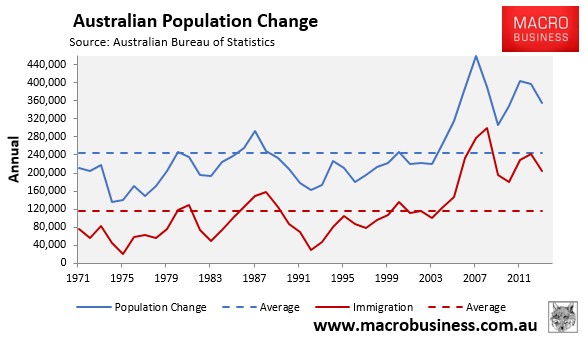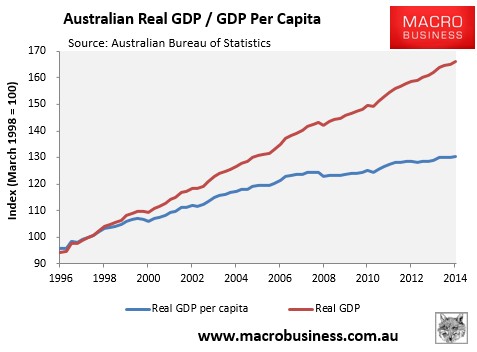One of the major costs of Australia’s blind march towards a “Big Australia”, which began a decade ago (see next chart), has been laid out in no uncertain terms by an audit from Infrastructure Australia, which forecasts a massive 290% increase in the costs of congestion by 2031, unless there is massive investment in new roads and public transport.

From ABC News:
IA says the cost of road delays in the six largest capital cities was $13.7 billion in 2011, but is projected to grow by around 290 per cent to $53.3 billion in 2031 without measures including new roads and more public transport funding.
The report says car travel times in the most gridlocked parts of Sydney, Melbourne, Brisbane, Perth, Adelaide and Canberra are expected to jump by at least 20 per cent if there no measures to boost capacity or curb demand.
“In some cases, travel times could more than double between 2011 and 2031,” the report says…
The audit estimates Australia’s population will grow to 30.5 million in 2031, with the biggest four cities growing by around 45 per cent…
The report predicts public transport demand will more than double in Melbourne, and jump by 55 per cent in Sydney, and nearly 90 per cent across other capital cities.
“Unless peak period passenger loads are managed and capacity is increased, commuters in all capital cities will see more services experiencing ‘crush loadings’, where peak demand exceeds capacity,” the report says…
It also says increased private and public funding will be needed to maintain and grow infrastructure networks.
“We’re increasingly going to need the private sector to be involved in infrastructure investment”…
Hardly sounds like a recipe for growing living standards, does it? And yet our governments continue to push on with the “growth is good” mantra, funneling more and more people into Australia’s largest cities.
The costs of this approach will, of course, be borne by you and I, who will be forced to spend more time in traffic jams as Australia’s infrastructure – already straining after a decade of rampant immigration – fails to keep up with demand.
We will then be called upon to pay for expensive new infrastructure (e.g. roads, rail and desalination plants) in a futile bid support the rapidly growing population, but it will never be enough to maintain living standards.
This infrastructure investment could also lower productivity by diverting investment away from productive areas (see my previous post).
Our children will then be required to live in smaller and more expensive housing, often further away from the CBD, as more and more people flood into our major capital cities.
And then in 30 years time, our children will be called upon to once again ramp-up the immigration intake once the current batch of migrants grows old and needs support – the very definition of a ponzi scheme.
About the only winners from the march towards a Big Australia will be big business, who will enjoy an ever growing customer base and will be able to increase sales without becoming more efficient.
Take, for example, Australia’s banks, which get the double bonus of not just having more consumers to sell debt to, but also extra demand for housing, which helps to support house prices and their loan collateral, especially given the urban consolidation policies operated by Australia’s states.
With a rapidly growing population, headline GDP will also grow faster than would otherwise be the case, making the government of the day look like better economic managers.
However, economic growth through population is an illusion – it expands the economic pie (more inputs equals more outputs) but leaves everyone’s share of that pie unchanged.
One only needs to view the below chart to see what I am talking about. Despite enjoying the biggest mining investment boom in history, per capita real GDP has risen by a paltry 4.8% since September 2008, versus 15.9% growth in overall real GDP (see next chart).

So more than two-thirds of Australia’s economic growth has come entirely from population growth, with growth in per capita terms anaemic at best, despite the huge mining investment boom over that period.
We should also not forget that Australia earns its way in the world mainly by selling its fixed mineral resources (e.g. iron ore, coal, natural gas, and gold). More people means less resources per capita. A growing population also means that we must deplete our mineral resources faster, just to maintain a constant standard of living. Even the high priest of a Big Australia, Bernard Salt, acknowledged as much yesterday:
“…there is always the mollifying effects of the lucky country’s perennial equation: 24 million people sharing the resources of an entire continent delivers prosperity far beyond our effort and talent.”
No, the key criteria that needs to be met in deciding whether to embark on a Big Australia is: “will it improve the living standards of the pre-existing population”? The answer to this question seems to be a resounding “no”.
As I have noted previously, if all Australia is doing is growing for growth’s sake, pushing against infrastructure bottlenecks, diluting our fixed endowment of minerals resources, and failing to raise the living standards of the existing population, what’s the point?

